Читать книгу The Amazon Jungle - Rick Cesari - Страница 14
На сайте Литреса книга снята с продажи.
IF YOU’RE NOT ON AMAZON, YOU’RE NOT ONLINE.
ОглавлениеI tell my clients, if you’re not on Amazon, your product isn’t really online. It’s a slight exaggeration, but I’m convinced that being on Amazon has become a necessity in today’s retail environment because Amazon has literally become The Internet of Products. Why? A major reason is that consumers don’t have to start on Amazon.com to wind up there. The company’s tentacles spread throughout the entire internet, and it is tough to avoid them. Forty-seven percent (47%) of people searching for a product to buy start their search on Amazon.com compared to 35% who use Google.11 And that’s not even the most amazing part. Because of Amazon’s long internet history and its massive online presence, search engines like Google and Bing give Amazon prime digital real estate on their Search Results Pages (SRPs). As a result, Amazon not only enjoys millions of unpaid organic search results links, but it also pays for clicks on those same search engines and comparison shopping engines (like Shopzilla and Pricegrabber) for top-ranking product search results. If all product searches lead to Amazon (and most do), then that’s where you need to be to sell your products. Simple as that.
The Google Search Results Page (SRP) pictured below demonstrates my point. In this scenario, a shopper enters two words into the Google search field: “water flask.” In return, several rows of information are displayed, starting with Google’s Product Listing Ads (PLAs). The pay-per-click PLA program gives priority position to products for which retailers have paid top dollar to drive traffic to their websites. In this case, Amazon has two products featured, the Hydro Flask and S’well bottles. Google AdWords Ads are displayed next, both with links to Amazon. Additionally, and as a result of Amazon’s page-rank power, Amazon products also top the free organic search results, with links back to their website. Of the nine product links for this SRP, Amazon owns five of them. Wait a minute. Is this Google or Amazon? (see image on next page)
Amazon also has millions of affiliate publishers, digital display banners (virtual billboards), review sites, and a dozen new media stories each week, all driving traffic to their platform. When it comes to consumers searching for a product to buy, Amazon has it locked down. Amazon.com has always been about selling you products and making that purchase as frictionless as possible. Every update or iteration since its inception has cleared the buyer’s path of roadblocks. Their entire e-commerce ecosystem is built around making the path to purchase as smooth and fast as possible, and no other competitor comes close to matching that experience. How do they do it?
Thirty years of purchasing data gives Amazon a tremendous advantage—especially because they are competing on their own platform against Sellers who don’t have access to the same information. They’ve been able to translate decades of Seller data into a delivery system that is custom-fit for their customer, or any customer for that matter. As a result, Amazon enjoys a much higher purchase intent than other e-commerce retailers. It’s not unusual for conversion rates to go as high as 25% on Amazon, for example, while other e-commerce sites are typically thrilled to see rates of 2 to 3%. The folks at Amazon Advertising put it best when they said that Facebook knows what you like, Google knows what you search, but Amazon knows what you buy! To further this point, Amazon Sponsored Brands, formerly known as Headline Ads, get 42% more clicks and 3.5 times the conversions compared to Google PLA Ads.12 I see these numbers every day when assessing data for my clients. Amazon has stopped at nothing to satisfy its customers. In return, their customers are more comfortable buying their products on Amazon than from any other online retailer.
